Multitask Vehicle Signal Recognition With Dual-Speed Adaptive Weighting
Abstract
In mixed traffic environments, the accurate identification of vehicular devices’ modulation schemes, communication protocols, and emitter device information directly affects perception capabilities toward surrounding vehicles and infrastructure. However, existing studies predominantly focus on single-dimensional information analysis, resulting in limited completeness and accuracy in signal feature interpretation. This paper proposes a multitask learning framework (DSR-CNN-LSTM) for collaborative identification of this information. Furthermore, to mitigate task conflicts and noise interference, a dual-rate adaptive weight adjustment strategy is developed to optimize model performance through dynamic balancing of task learning rates and gradient update speeds. Experimental results demonstrate the superior performance of the DSR-CNN-LSTM framework in complex communication environments: Modulation recognition accuracy shows improvements of 20.67%, 10.38%, and 9.96% on three open-source datasets, while the weighted average recognition accuracy for communication protocols and emitter device information achieves enhancements of 45.52%, 72.21%, and 11.11%, respectively. The proposed model outperforms existing methods in both recognition precision and anti-interference capabilities, providing novel technical insights and solutions for the advancement of intelligent connected vehicle technologies.
1. Introduction
In recent years, the rapid advancement of intelligent driving technologies has established wireless signal recognition as a critical enabler for vehicle control, road perception, and intelligent traffic management [1]. While 5G and 6G technology [2]—with its high data transmission rates, low latency, and high reliability [3]—has driven substantial technological innovation and economic growth [4], it has simultaneously intensified spectrum interference and complicated electromagnetic environments.
A complex traffic environment can lead to signal attenuation and interference [5], and different signal recognition techniques are required to adapt to these variations and ensure stable communication. Modulation recognition [6], protocol adaptation [7], and emitter identification [8] in vehicular signals enable vehicles to decode and process signals from other vehicles or infrastructure in real time. Specifically, modulation recognition ensures accurate decoding of diverse vehicular signal modulation schemes. Protocol recognition facilitates seamless communication between autonomous and conventional or other autonomous vehicles. Emitter identification supports the precise behavioral prediction of surrounding traffic participants. Consequently, effective wireless signal recognition is critical for enhancing communication efficiency, enabling real-time information sharing [9], improving traffic flow, promoting road safety, and supporting the deployment of emerging technologies [10]. However, current research on multitask signal recognition (MTSR) mainly focuses on automatic modulation recognition and signal classification tasks [11], where limited task dimensions result in imbalanced resource utilization and constrained feature interpretation.
To address the limitations in current research, this paper proposes a CNN-LSTM-based MTSR framework that achieves joint analysis of modulation types, communication protocols, and emitter device information. Task segmentation enhances recognition professionalism and accuracy, optimizes resource allocation, and improves anti-interference capability. Furthermore, this paper introduces a novel adaptive weight adjustment strategy that dynamically coordinates task weights through both learning rates and gradient update velocities. This approach alleviates task conflicts and interference impacts on system performance, effectively mitigating task competition while enhancing recognition capabilities.
- 1.
Expansion of task dimensions: This study integrates multiple dimensions, including modulation schemes at the physical layer, communication protocols at the link layer, and emitter information at the device layer, into a unified analytical framework. This approach mitigates the limitations in signal feature analysis caused by insufficient task coverage and significantly improves signal recognition accuracy and real-time performance in complex traffic environments.
- 2.
Optimization of task conflicts: To address performance degradation caused by task conflicts and feature competition, this study proposes an adaptive weight adjustment strategy that balances learning velocity and gradient. This method mitigates training instability induced by task interference, effectively enhancing robustness and generalization capability in complex noise environments.
The organization of this paper is as follows. Section 2 reviews related research in the field of signal recognition. Section 3 introduces the multitask learning (MTL)–based signal recognition approach and adaptive weight adjustment technique. Section 4 discusses the effectiveness and advancement of the proposed methods through experimental comparative analysis. Finally, Section 5 summarizes the main contributions of this research and suggests future research directions.
2. Related Work
-
Automatic modulation recognition (AMR) [12]: Modulation techniques directly affect the transmission efficiency and interference resistance of signals. As an intermediary step between signal detection and demodulation, AMR allows for identifying the modulation type of a signal without prior knowledge of the system parameters [12]. This improves demodulation quality and communication efficiency and optimizes the signal reception process [13]. Reference [6] applied two different CNN models for modulation recognition on the RadioML2016.10a and an image dataset, achieving accuracies of 53.65% and 94.39%, respectively. Reference [14] proposed an AMC method based on deep residual neural networks and mask modeling techniques, significantly enhancing modulation types’ recognition performance under limited signal samples, especially in low SNR ratio environments.
-
Communication protocol identification (CPI): Communication protocols define the data format, content, and timing of information in wireless systems, closely related to their data structures, transmission systems, data types, and application types [7]. Therefore, this technology ensures the correct parsing of routed data and proper handling by network devices by determining the specific communication standards or protocols the signal uses. Reference [7] utilized multidimensional convolutional neural networks to enhance the accuracy and efficiency of wireless protocol identification and introduced a spatial convolutional pooling neural network to improve the flexibility and accuracy of variable–length protocol recognition. Reference [15] employed an incremental learning strategy to adapt to IoT devices’ continuous growth and operational changes, performing exceptionally well with limited signal samples and in low SNR ratio environments.
-
Specific emitter identification (SEI): The unique characteristics produced by transmitting devices’ physical or operational properties are often referred to as the “fingerprint” of a signal. SEI utilizes these fingerprint features to identify and distinguish specific signal sources, making this technology widely applied in fields such as military, security surveillance, and spectrum management to prevent illegal access and interference. Reference [16] introduced a small-sample SEI method using self-supervised learning and adversarial enhancement, suitable for situations with scarce signal samples and limited labeling. Reference [8] proposed a semisupervised SEI method based on metric adversarial training, which effectively extracts distinctive and generalizable semantic features of wireless signals, enhancing the accuracy and robustness of emitter identification [17].
-
MTSR: Advanced technologies in the field of wireless signal recognition often focus on independently researching these subtasks. When data are scarce, models that are not fully trained may perform poorly and can be prone to overfitting on specific tasks. Through the sharing of knowledge between tasks, MTL enhances the model’s ability to learn from limited data while reducing the total amount of parameters and computational resources required. Reference [18] marks the first use of deep neural networks and an MTL framework in wireless communications to study AMR and SEI simultaneously. Reference [19] focuses on classifying modulation modes and communication protocols; the proposed MTL architecture benefits from the interrelationships between these two tasks, improving classification accuracy and learning efficiency.
Research indicates that conflicts and interference between tasks, resulting in negative correlations, can lead to performance degradation, especially in noisy environments with low SNR ratios, where conflicts are more likely to obscure helpful information in the signals. By optimizing weight allocation strategies, it is possible to balance resources and mitigate task conflicts effectively [20]. However, inappropriate strategies can reduce learning efficiency and result in resource wastage.
Therefore, this study proposes a CNN-LSTM-MTL framework that can identify the modulation modes, communication protocol, and specific emitters of signals and introduces an adaptive weight adjustment strategy that considers learning difficulty and speed. This strategy effectively reduces conflicts and interference between tasks, enhancing task recognition performance.
3. Materials and Methods
3.1. MTL Model Based on CNN-LSTM
As a machine learning paradigm, MTL learns more robust and general representations by sharing model structures and data across different tasks. This approach not only builds more robust models but also facilitates knowledge sharing between tasks, significantly enhancing the performance of each task while reducing the risk of overfitting [21].
In wireless communications, primary efforts have been focused on AMR and signal classification [18, 19]. However, vehicular signals inherently contain integrated information encompassing modulation schemes, protocol specifications, and device fingerprints. The existing insufficient task coverage may constrain feature analysis capabilities and impede comprehensive data interpretation. To address this research gap, this study integrates AMR, CPI, and SEI tasks, proposing a CNN-LSTM-based MTL framework. As illustrated in Figure 1, this model employs a hard parameter sharing strategy [22], optimizing the model structure by sharing lower level network parameters while retaining task-specific parameters in higher layers. This facilitates knowledge transfer between different tasks and enhances the model’s generalization ability [23].
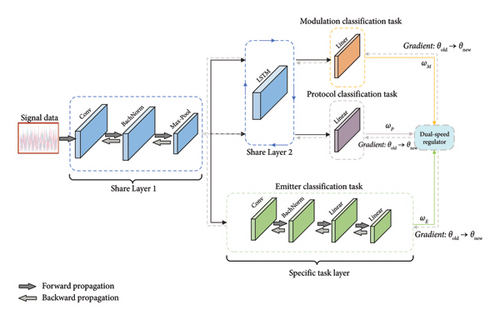
The model includes two shared layers based on CNN and LSTM, respectively. Considering the correlation of subtasks in frequency patterns and amplitude variations, the input signal is treated as two-dimensional time-frequency spectral data. The CNN’s convolution operations effectively capture the signal’s local features, serving as the standard foundational features for all tasks. AMR and CPI often require handling signals’ continuity and contextual relationships. LSTM, adept at capturing long-term dependencies, is chosen as the shared layer for these two subtasks to understand the temporal patterns of the signals better. Moreover, AMR and CPI extract the most relevant information from shared features through specific fully connected layers for classification prediction. For SEI, given its typically fixed spectral or waveform characteristics and relative stability in the signal’s spatial domain, independent of temporal changes, CNN is used to extract advanced features further, focusing on the unique signal details of these task samples.
By extracting spatial features through CNN and capturing temporal dependencies with LSTM, the model is better equipped to handle complex wireless signal data. Moreover, regularization techniques are employed to enhance the model’s performance on the test set to prevent performance degradation caused by overfitting.
3.2. Dual-Speed Regulator (DSR) Adaptive Weight Adjustment Strategy
In MTL research, there is a potential for conflicts between different tasks, where improving the model’s performance on one task may impair the performance of another task that has different requirements [22]. This phenomenon is known as negative transfer or destructive interference [24].
Researchers have explored various adaptive weight adjustment strategies to mitigate the effects of interference. Dynamic weight averaging (DWA) [25], for instance, assigns more attention to tasks that have recently underperformed by observing the relative improvement in task losses [26].
-
Algorithm 1: DSR adaptive weight adjustment algorithm.
-
Input:
-
N: The total number of tasks;
-
ωt: The weight for task t;
-
τ: Temperature parameter;
-
Lt(i): The loss for task t at epoch i;
-
α: Sensitivity parameters for gradient norm adjustment;
-
gt: The gradients for each task;
-
Gavg: The average gradient norm across tasks;
-
β: The hyperparameter controls the strength of the weight;
-
Output: The optimized parameters
-
1. Initialize network parameters;
-
2. for n = 1 to MaxEpochs do
-
3. for t = 1 toNdo
-
4. Forward propagate to get the output for task t;
-
5. Compute the rate of loss change for task t using equation (1);
-
6. Compute the gradient equilibrium index for task t using equation (2);
-
7. Compute the weight influence factor for task t using equation (3) (for optimal task prioritization based on difficulty and performance);
-
8. Compute the weight for task t using equation (5);
-
9. end for
-
10. Compute the weighted total loss as
-
11. Update model parameters by backpropagation;
-
12. end for
However, excessive focus on underperforming tasks may lead to performance degradation in tasks performing well due to instability over long-term training. The GradNorm strategy [27] adjusts the gradient magnitudes of task losses to ensure that all tasks converge at similar rates during training. However, it lacks sensitivity to changes in task difficulty, leading to excessive balancing among tasks. Considering both factors, we proposed a hybrid adaptive weight adjustment method called DSR, illustrated in Algorithm 1.
3.3. CNN-LSTM-MTL Based on Adaptive Weight Fusion
This paper combines the designed CNN-LSTM model with the DSR adaptive weight adjustment strategy into a new MTSR architecture, DSR-CNN-LSTM, as illustrated in Figure 2.
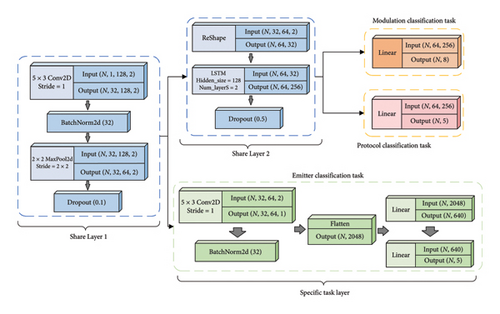
Preprocessed signal data are passed through a convolutional shared layer to extract foundational features for all tasks. An LSTM shared layer, designed explicitly for AMR and CPI, extracts the temporal characteristics of the samples, while the SEI task further utilizes convolutional operations to analyze advanced spatial features. The intertask correlations may affect the learning outcomes. The DSR strategy uses losses and model gradients to calculate weights for each task, with each task computing its specific loss function. These weights are then processed and used to update network parameters through backpropagation. This flexible and efficient approach allows the network to continuously adjust and optimize during training, enabling different tasks to mutually enhance each other, increase the positive impacts among related tasks, and reduce interference from irrelevant or negative impact tasks.
4. Results and Discussion
4.1. Experimental Environment and Parameter Setting
This study was conducted on an Ubuntu 18.04 server configured with the Pytorch1.11.0 framework and equipped with an NVIDIA RTX 3090 graphics card featuring 24 GB of video RAM.
Hyperparameter search was performed using the Tree-structured Parzen Estimator (TPE) algorithm based on Bayesian optimization. We adopted TPE because it adaptively constructs a model of promising hyperparameter regions, enabling efficient exploration of high-dimensional search spaces and faster convergence to optimal settings compared to grid or random searches. The study ultimately employed the Adam gradient descent algorithm for training the network over 40 epochs—a duration determined empirically through preliminary tests indicating that most models tended to converge in fewer than 40 epochs, thus balancing computational cost and performance gains—integrating a cosine annealing weight decay strategy to optimize the learning process, with an initial learning rate set at 0.0001. This relatively small initial learning rate helps stabilize training, especially when dealing with multiple tasks simultaneously. Additionally, based on the TPE strategy, the temperature parameter in the previously mentioned DSR weight adjustment strategy was set to 2, the weight sensitivity parameter was set to 1.5, and the weight balance parameter was set to 0.5. These values were selected to fine-tune the balance between each subtask’s loss and to control the responsiveness to fluctuations in training progress. The temperature parameter determines the sharpness of the weight distribution, the weight sensitivity parameter adjusts how quickly weights shift with changes in loss, and the weight balance parameter sets the baseline ratio among tasks.
4.2. Dataset Settings
References [18, 19] utilize GNURadio to generate communication signal data at various SNRs for MTSR research. The RadComAWGN and RadComDynamic datasets have a sampling rate of 10 MS/s, simulating scenarios where propagation effects and hardware uncertainties affect signal propagation and waveforms. The SNR ranges from −20 dB to 18 dB, with increments of 2 dB. The RadComOTA dataset simulates more challenging over-the-air propagation scenarios, including additional noise and interference. Here, the receiver samples IQ data at a central frequency of 2.45 GHz and a rate of 10 MS/s, with an SNR range from 0 to 32 dB in 4 dB steps, containing over 8 million IQ samples each length of 128.
As shown in Table 1, the RadComAWGN dataset includes nine types of modulation and 11 signal categories. In contrast, the RadComDynamic and RadComOTA datasets share the same label and comprise six types of modulation and eight signal categories.
| RadComAWGN dataset | |
|---|---|
| Modulation classes | Signal class |
| BPSK | STACOM |
| ASK | Short-range |
| AM-DSB | AM Radio |
| AM-SSB | |
| GFSK | Bluetooth |
| DSSS-CCK | IEEE802.11bg |
| DSSS-OQPSK | IEEE802.15.4 |
| FMCW | Radar-Altimeter |
| PCW | Airborne detection |
| Airborne range | |
| Ground mapping | |
| Air-Ground-MTI | |
| RadComDynamic and RadComOTA dataset | |
| BPSK | STACOM |
| ASK | Short-range |
| AM-DSB | AM Radio |
| AM-SSB | |
| FMCW | Radar-Altimeter |
| PCW | Airborne detection |
| Airborne range | |
| Ground mapping | |
| Air-Ground-MTI | |
Building on these three datasets, we further subdivided them to identify communication signal modulation, communication protocols, and specific emitter classes. As shown in Table 2, after removing signals that are neither protocol nor emitter categories, the new RadComAWGN dataset contains eight modulations, five protocols, and five emitter categories. The new RadComDynamic and RadComOTA datasets include five modulations, two protocols, and five emitter categories. Signals such as STACOM, AM Radio, Bluetooth, IEEE802.11bg, and IEEE802.15.4 focus on data transmission and communication standards to ensure compatibility and communication efficiency between different devices and are categorized under protocol types. On the other hand, signals such as Radar-Altimeter, Airborne-detection, Airborne-range, Ground mapping, and Air-Ground-MTI are more focused on performing specific tasks, usually associated with specific equipment applications and often used for precise detection and measurement tasks, thus categorized under specific emitter types. Considering that our protocol and emitter identification tasks are subdivisions of the original dataset’s signal classification tasks, the protocol and emitter labels in the new dataset are mutually exclusive. When a category label is missing, we set it to null.
| RadComAWGN dataset | ||
|---|---|---|
| Modulation classes | Protocol classes | Emitter classes |
| BPSK | STACOM | Radar-Altimeter |
| AM-DSB | AM Radio | Airborne detection |
| AM-SSB | ||
| GFSK | Bluetooth | Airborne range |
| DSSS-CCK | ||
| DSSS-OQPSK | IEEE802.11bg | Ground mapping |
| FMCW | ||
| PCW | IEEE802.15.4 | Air-Ground-MTI |
| RadComDynamic and RadComOTA dataset | ||
| BPSK | STACOM | Radar-Altimeter |
| AM-DSB | Airborne detection | |
| AM-SSB | AM radio | Airborne range |
| FMCW | Ground mapping | |
| PCW | Air-Ground-MTI | |
Finally, the processed signal samples are divided into training, validation, and test sets in a 7 : 2 : 1 ratio. They are standardized to reduce bias, enhance model performance, and reshaped into complex (IQ) tensors of 128 × 2 to match the network input.
4.3. Model Comparison Evaluation
To identify the most suitable model structure for the proposed MTSR, we used samples with SNRs of −10, −2, and 8 dB from the RadComAWGN dataset as the test set to assess the recognition capabilities of various models under low, medium, and high SNR conditions.
As shown in Table 3, all models reached their accuracy limits under high SNR conditions. Since samples at medium and low SNRs contain more noise interference and present higher challenges in feature extraction, these conditions better test the models’ recognition abilities. Therefore, the results of model recognition at low and medium SNRs serve as the basis for model selection in this study.
| Model | AMR accuracy (%) | CPI accuracy (%) | SEI accuracy (%) |
|---|---|---|---|
| CNN | 99.87 | 99.77 | 100 |
| LSTM | 99.61 | 99.51 | 100 |
| SNN | 99.87 | 99.77 | 100 |
| ResNet18 | 99.87 | 99.77 | 100 |
| CNN-LSTM | 99.87 | 99.77 | 100 |
| SNN-LSTM | 99.87 | 99.77 | 100 |
- Note: The bold values represent the optimal recognition performance in all models.
Different models exhibit their respective strengths and limitations, as illustrated in Tables 4 and 5. CNNs excel in recognizing protocols and emitters by automatically learning the hierarchical spatial features of the data, but they are less effective when dealing with complex or abstract modulation features. LSTMs are proficient in processing time series data, yet they are less effective than image-based methods in recognizing emitter characteristics. SNNs demonstrate balanced high performance across various tasks, with their spike-timing processing being susceptible to subtle changes in communication signals, making them suitable for handling diverse tasks. However, their performance is slightly less than ideal due to the nature of updating parameters through surrogate gradients. ResNet18’s hierarchical feature extraction is particularly effective in deciphering complex modulation patterns and communication protocols, but it lacks the capability to capture unique features related to emitters.
| Model | AMR accuracy (%) | CPI accuracy (%) | SEI accuracy (%) |
|---|---|---|---|
| CNN | 92.34 | 99.48 | 91.15 |
| LSTM | 97.79 | 98.96 | 79.43 |
| SNN | 97.79 | 98.96 | 90.62 |
| ResNet18 | 98.44 | 98.70 | 82.55 |
| CNN-LSTM | 99.35 | 99.74 | 91.93 |
| SNN-LSTM | 98.44 | 99.48 | 89.06 |
- Note: The bold values represent the optimal recognition performance in all models.
| Model | AMR accuracy (%) | CPI accuracy (%) | SEI accuracy (%) |
|---|---|---|---|
| CNN | 66.10 | 84.58 | 39.63 |
| LSTM | 64.16 | 80.46 | 24.15 |
| SNN | 62.86 | 84.58 | 37.01 |
| ResNet18 | 64.94 | 83.80 | 30.71 |
| CNN-LSTM | 67.66 | 84.83 | 40.16 |
| SNN-LSTM | 67.40 | 84.01 | 31.76 |
- Note: The bold values represent the optimal recognition performance in all models.
Considering the above performance, different models and techniques have advantages when processing different aspects of communication signals and can serve as a basis for network design. Therefore, we integrate the models’ strengths to design a hybrid model structure suitable for simultaneously handling AMR, CPI, and SEI tasks. Among these, the CNN-LSTM model, which combines the spatial feature extraction of CNNs with the temporal processing capabilities of LSTMs, performs best across all tasks. In contrast, the combination of SNN and LSTM, while leveraging the advantages of spike processing and temporal capture, does not perform as well overall as the CNN-LSTM model, which optimizes both spatial and temporal features.
4.4. Ablation Contrast Analysis
To verify the effectiveness of the proposed DSR adaptive task weight adjustment strategy, we conducted an ablation comparative analysis using the RadComAWGN dataset, setting the SNR range from −20 to 18 dB and the learning rate at 0.0001. In the CNN-LSTM-MTL model, the weights for all tasks were set to 1, while the DSR-CNN-LSTM-MTL model employed the DSR weight adjustment strategy.
Although the recognition performance of our designed CNN-LSTM model is already approaching a high level without using a weight adjustment strategy, achieving accuracy rates close to 100% when SNR > 2 dB, the DSR weight adjustment strategy considers both task learning and gradient optimization speeds. This ensures that the model does not overoptimize one task at the expense of others, thereby helping to balance the learning needs of different tasks in MTL.
As shown in Figure 3, the DSR-CNN-LSTM model applying the weight adjustment strategy demonstrates higher accuracy across all tasks at various SNR levels compared to the CNN-LSTM model without this strategy. Particularly in low SNR environments (SNR < −4 dB), this strategy significantly enhances the model’s robustness, with a rapid improvement in accuracy, whereas the improvement with CNN-LSTM is more gradual. Moreover, the dashed line represents the SNR value at which all models simultaneously reach their performance limits. The figure shows that the DSR-CNN-LSTM reaches its peak performance more quickly as the SNR increases, whereas the CNN-LSTM requires a higher SNR to achieve similar accuracy rates. These findings indicate that our proposed DSR weight adjustment strategy helps the model learn and adapt faster in complex signal environments and enhances the model’s ability to decode signals.
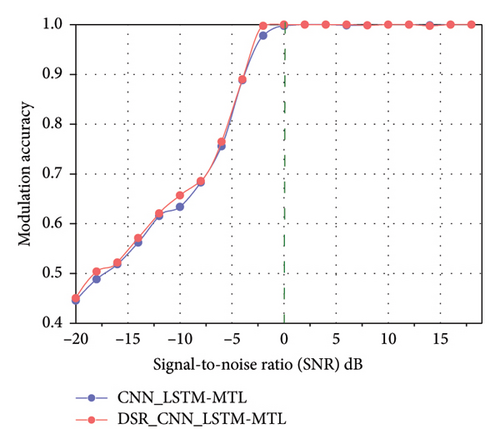
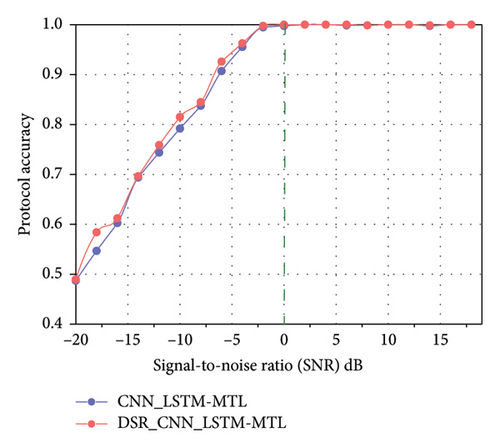
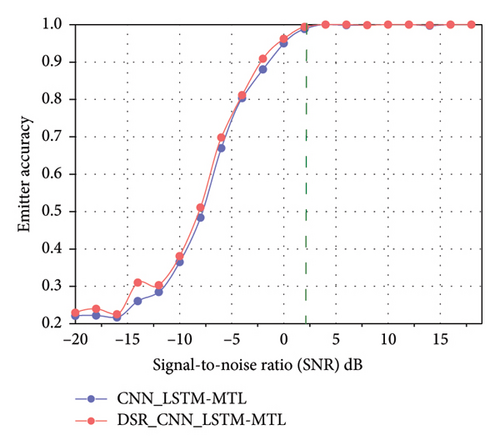
Figure 4 presents a performance comparison of the two models under the RadComAWGN dataset, where our proposed DSR-CNN-LSTM model consistently outperforms the L-CNN network across all SNR levels. Specifically, Figure 4(a) shows the recognition performance for the AMR task, where the DSR-CNN-LSTM reaches convergence at −2 dB compared to 4 dB for L-CNN, demonstrating the higher learning efficiency of our model. Furthermore, in low SNR conditions for the modulation recognition task, the model also exhibits better adaptability and robustness. Calculating the weighted average accuracy across different SNR levels, the AMR average performance improvement is 20.67% when SNR < 0 dB.
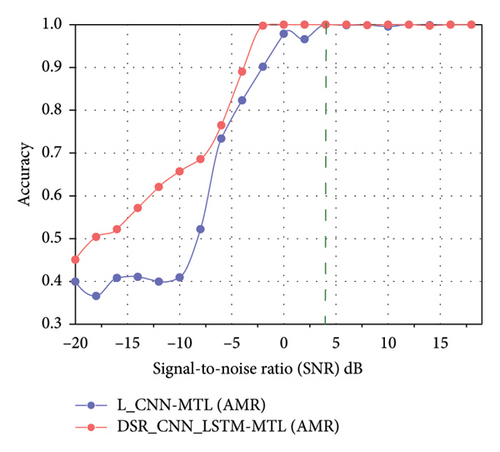
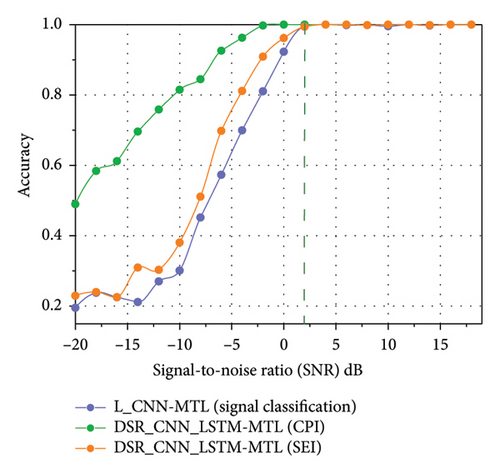
Due to our subdivision of the original experiment’s signal classification task into CPI and SEI tasks, we conducted a comparative analysis of these tasks together, as shown in Figure 4(b). The subdivided CPI and SEI subtasks maintain recognition performance at all SNR levels that are not inferior to L-CNN, with CPI exhibiting a high recognition accuracy under low SNR conditions and beginning to converge at SNR = −2 dB. Although SEI is more challenging regarding feature extraction, its recognition accuracy rapidly increases when SNR exceeds −10 dB. Both subtasks significantly surpass the performance of the L-CNN model in the combined signal classification task under the same SNR conditions, with a weighted average performance improvement of 45.52% for both tasks when SNR < 0 dB.
The RadComDynamic dataset simulates conditions where signals are affected by waveform and hardware effects, containing more interference and noise. Figure 5 presents a performance comparison of various tasks under this dataset. When the SNR ranges from −20 to −10 dB, the L-CNN model exhibits considerable performance fluctuations across tasks. In contrast, the DSR-CNN-LSTM model, while not showing significant performance improvements, demonstrates better noise suppression and signal recovery capabilities. As shown in Figure 5(a), when the SNR exceeds −10 dB, the performance of the DSR-CNN-LSTM model rapidly improves and converges at 4 dB, whereas L-CNN shows performance lag. The average performance improvement under conditions where SNR < 0 dB is 10.38%. Furthermore, the DSR-CNN-LSTM performs exceptionally well in the CPI task, as depicted in Figure 5(b), achieving higher accuracy under low SNR conditions and converging significantly faster than L-CNN. Although the SEI task shows a performance improvement trend similar to L-CNN, its accuracy performance is notably superior to that model. Compared to the original study’s signal classification task, the weighted average performance improvement for CPI and SEI under SNR < 0 dB conditions is 72.21%.
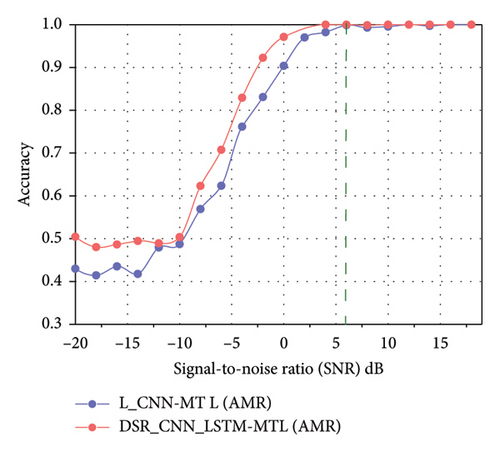
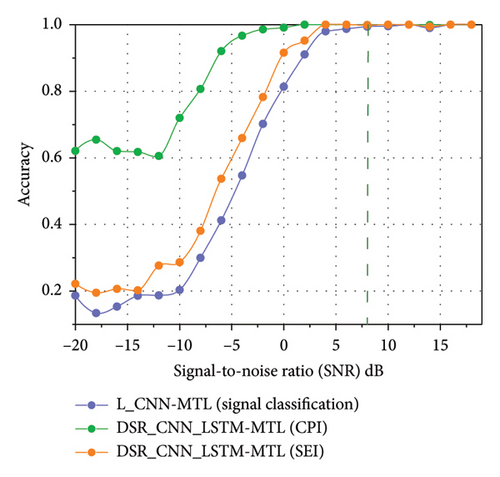
The RadComOTA dataset simulates over-the-air propagation conditions, presenting more significant challenges and practical relevance. The authors collected samples under varying signal strengths by adjusting the transmission gain. Figure 6 displays the recognition performance under this dataset. Since the SNR range for the RadComOTA dataset spans from 0 to 32 dB, in increments of 4, and the DSR-CNN-LSTM achieves higher recognition accuracy under high SNR conditions, Figure 6(b) shows that the accuracy for CPI and SEI tasks is close to 100% across all SNR levels, significantly outperforming L-CNN with an average performance improvement of 11.11%. In Figure 6(a), although the accuracy of DSR-CNN-LSTM is lower than that for other tasks, it still exceeds 90%, while L-CNN remains below 80%, yielding an average performance improvement of 9.96%.
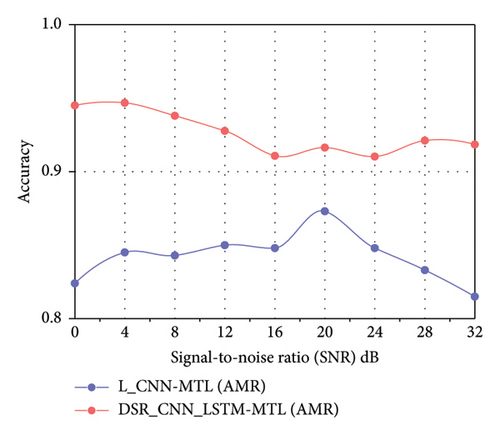
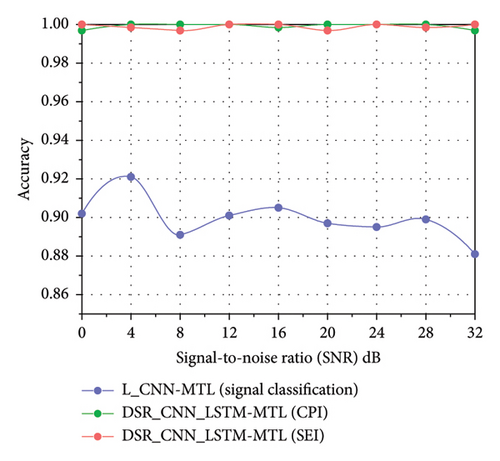
Based on the above comparative analysis, our proposed model effectively integrates the spatial feature extraction capabilities of CNN with the temporal processing abilities of LSTM, combined with the adaptive weight adjustment strategy. This model demonstrates exceptional noise suppression and signal recovery capabilities under low SNR conditions. Additionally, it exhibits superior learning speed, achieving performance convergence more quickly, and its recognition accuracy is significantly higher than that of other models.
5. Conclusions
This paper proposes an MTL architecture, DSR-CNN-LSTM, for joint recognition of modulation schemes, communication protocols, and specific emitter characteristics. Meanwhile, we introduce a novel adaptive weight adjustment strategy, the dual-velocity regulator, that dynamically coordinates specific task learning velocities and gradient update rates to mitigate performance degradation caused by task conflicts. Comparative analysis shows that on RadComAWGN, RadComDynamic, and RadComOTA datasets, DSR-CNN-LSTM achieves average accuracy enhancements of 20.67%, 10.38%, and 9.96%, respectively, for AMR compared to state-of-the-art approaches. For CPI and SEI, the weighted average performance improvements over the signal classification task are 45.52%, 72.21%, and 11.11%, respectively. The proposed model outperforms other models across various SNR levels, demonstrating enhanced robustness and anti-interference capabilities, particularly in low signal-to-noise ratio environments. Through the synergistic sharing of task features, the model significantly improves the reliability and real-time performance of intervehicle communication, providing efficient and reliable technical support for the future development of intelligent transportation systems.
However, the relatively complex weight adjustment strategy increases the computational burden, thereby affecting the real-time analysis of signals. In future work, we will explore more lightweight model frameworks or conflict mitigation techniques to reduce computational overhead and better adapt to resource-constrained edge device scenarios.
Conflicts of Interest
The authors declare no conflicts of interest.
Author Contributions
Conceptualization, D.C. and X.S.; methodology, D.C. and X.S.; validation, D.C., X.S., and Z.C.; formal analysis, D.C., X.S., and Z.C.; investigation, D.C., X.S., and X.W.; resources, D.C., X.S., and X.W.; data curation, D.C., X.S., and X.W.; writing – original draft preparation, D.C. and X.S.; writing – review and editing, D.C., X.S., Z.C., and W.N.; visualization, D.C.; supervision, Z.C. and W.N.; project administration, Z.C. and W.N.; funding acquisition, W.N. All authors have read and agreed to the published version of the manuscript.
Funding
This work was supported by the Central Funds Guiding the Local Science and Technology Development under Grant No. 236Z0806G, the National Natural Science Foundation of China under Grant No. 62372021, and the Open Competition Mechanism to Select the Best Candidates in Shijiazhuang, Hebei Province, China.
Open Research
Data Availability Statement
The data that support the findings of this study are openly available in Github: “RadarCommDataset” at https://doi.org/10.1016/j.comnet.2021.108441 [28].




